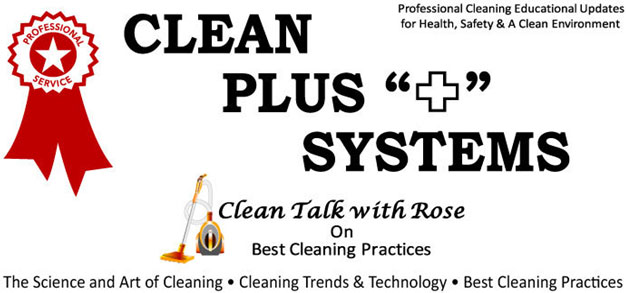Clean Talk with Rose
By Rose Galera, CEH
Hawaii Hospitality Magazine, Mar/Apr 2008
Dear Rose,
The word ‘Fomite’ has come up frequently in talking with fellow colleagues reference to Housekeeping and Food Sanitation. Any further information or explanation you can share to best understand its meaning and affect for Housekeeping training will be appreciated.
I Am Bugged
Dear Bugged,
During the Spring of 2007, Executive Housekeepers from Hawaii attended the I.E.H.A., PSWD Convention held at the University of Arizona. All had an educational opportunity to attend an excellent learning workshop presented by Dr. Charles Gerba, PhD, on the topic of Fomites. The title of the workshop was ‘Beware of the Fomites,’ its significance in disease transmission, research and testing information performed by the University of Arizona’s Departments of Soil, Water and Environmental Science and Epidemiology and Biostatistics AZ were presented by Dr. Gerba. The following information gathered from Dr. P. Gerba’s power-point presentation, was also shared at an educaLional session for Executive Housekeepers of the I.E.H.A., Hawaii Chapter. It is shared here as important information for all Housekeeping and/or Food Sanitation training programs.
What Is Fomite?
A fomite (FOE-mite) is a physical object that serves to transmit an infectious agent from person to person. For example, a comb infested with one or more head lice would be a fomite, Likewise, the dust particles containing infectious cold virus that remain after droplets of infected saliva are coughed into the air are fomites. Other examples of common fomites are sponges, cleaning cloths, cutting boards, hair brushes, combs, tissues, toothbrushes, forks and spoons, drinking cups and more . . . Other Critical Control Points of Fomites in a guest room setting are: phones, desk tops, key boards, mouse, toilet seats, bathroom sinks, trash receptacles and remote controls.
Why Study and Know About Fomite?
Fomites are believed to play a significant role in 1) transmission of respiratory and enteric (intestinal) viruses; 2) the cross-contamination of foodborne pathogens in the food service industry and in the home; 3) the amplification of bacteria and fungi (sponge/dishcloths); 4) Identifying areas where greatest risk of transmission can occur; 5) determination of risks of infection and success of interventions in reduction of risk.
It is important to be aware that common pathogens are transmitted via contaminated environmental surfaces. Pathogens are microorganisms that can cause disease in other organisms, humans, animals, or plants.
Home is Where the Germs Are
A look at the infection rates for everyday objects in the home and may apply also to hotels and/or condominiums:
Toilet Handle – 40%
Phone Receiver – 80%
Bath Faucet – 50%
TV Remote – 60%
Light Switches – 60%
Computer – 40%
Kitchen Faucet – 60%
Door Knobs – 60%
Microwave – 60%
Refrigerator – 60%
Common Pathogens Transmitted via Contaminated Environmental Surfaces.
Bacterial Pathogens
Salmonella E. coli Listeria
Clostridium difficile Staphylococcus aureus
Viral Pathogens
Rotavirus
Respiratory syncytial virus (RSV)
Norovirus
Enterovirus
Rhinovirus
Key factors to consider
• The kitchen is more heavily contaminated than the bathroom.
• Ordinary cleaning practices do little to reduce the microbial load.
• Use of hypochlorite cleaning products resulted in a significant reduction in HPC, coliforms, and fecal coliforms both in average and peak values.
• Risk of infection could be reduced greater than 99.99% on cutting boards and kitchen counter- tops by use of orite cleaning products.
Microorganisms Associated with Outbreaks in Public Toilets are:
• Shigella – Diarrhea
• Salmonella – Diarrhea
• Hepatitis A virus – Liver Disease
• Norovirus – Vomiting and Diarrhea
Aerosals are produced during toilet flushing:
• Fecal bacteria and viruses are ejected from the toilet during flushing.
• The droplets settle out in the restroom contaminating the restroom with fecal microorganisms.
Hand-Washing Findings:
• 95 percent of people say they wash their hands after using a public washroom
• 67 persent actually wash their hands
• 33 persent of those use soap
• 16 persent really wash long enough
Most Disease are spread through hand contact therefore Handwashing is very important
Bacterial Reduction on the Hands: average of all published studies
|
Product |
Percentage Reduction in Bacteria |
|
Plain soap |
92 %
|
|
Chlorhexidine |
99.6 %
|
|
Alcohol gels |
99.8 %
|
Fomites will continue play a major role in disease transmission now and into the future. Good hygiene is not cleaning more, but focused and targeted use of disinfectants.
After reading the above, it is not difficult to realize the importance of such training with all in the professional cleaning field. It is imperative that leaders in the cleaning industry teach, promote and practice the Environmental Stewardship Principles found in the book titled ‘Protecting the Built Environment, Cleaning For Health’ by Michael A. Berry, Ph.D. These include:
• Clean for health first and appearance second.
• Minimize Human exposure to contaminants and cleaning products
• Recognize cleaning as an environmental health benefit.
• Commit to occupational development of cleaning personnel
• Communicate the value of healthy buildings.
• Minimize chemical, particle and moisture residue when cleaning.
• Ensure for worker and occupant safety.
• Contain and reduce all pollutants entering the building.
• Dispose of cleaning products in environmentally safe ways.
• Establish and document routine maintenance schedules.
Happy Training! Rose

